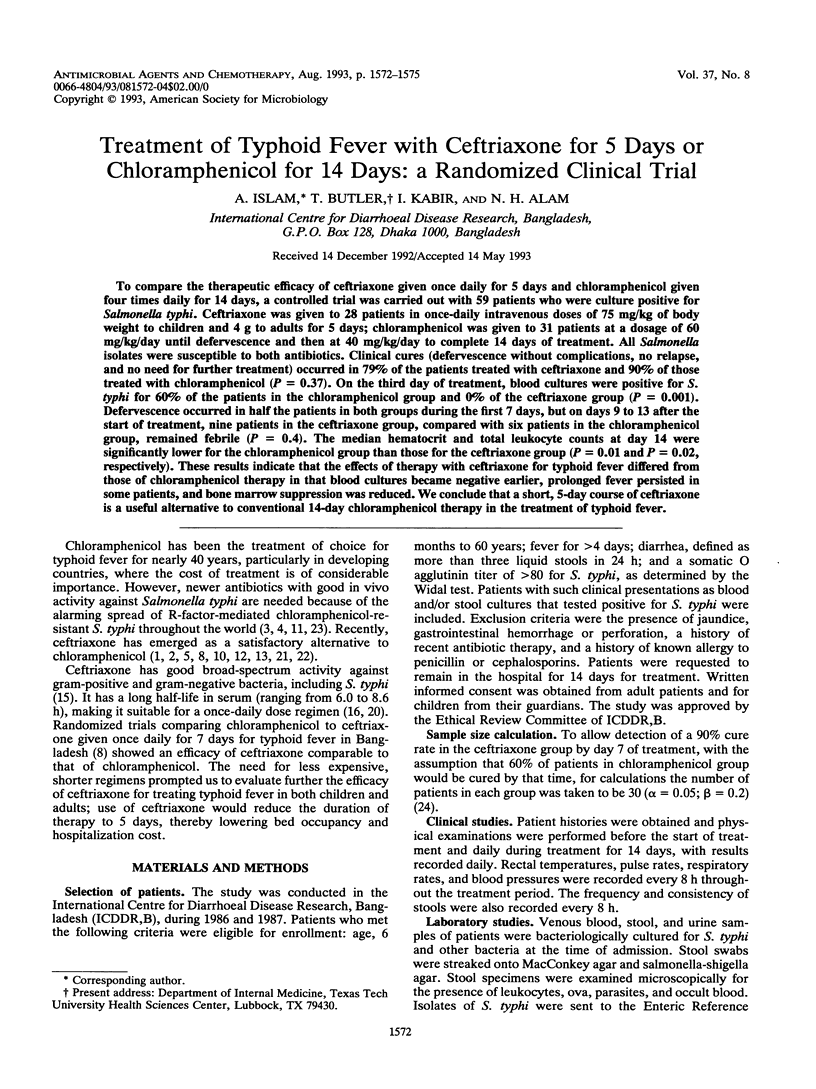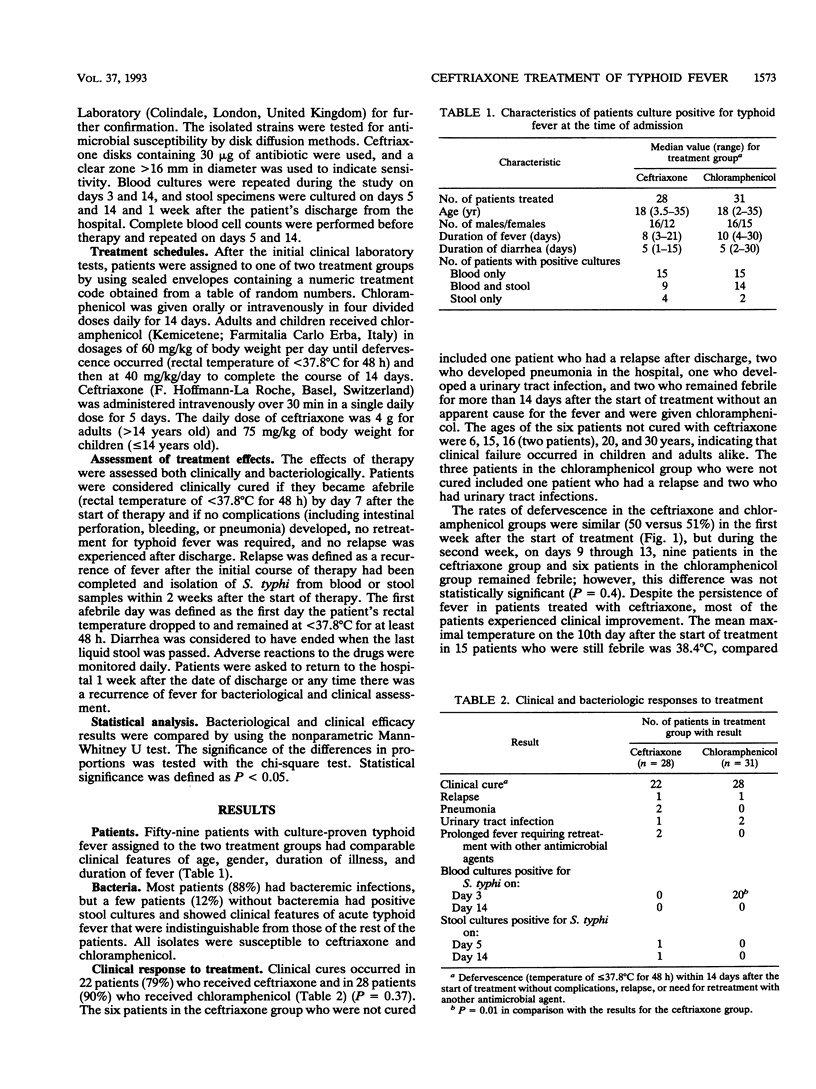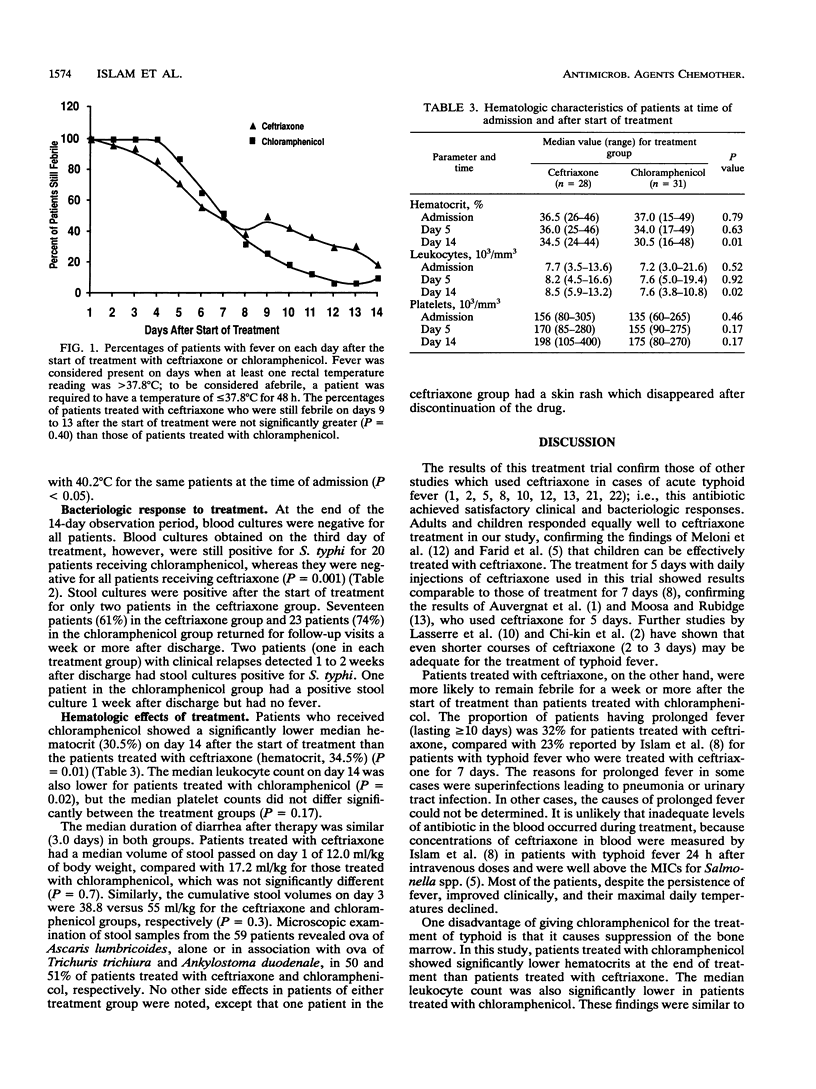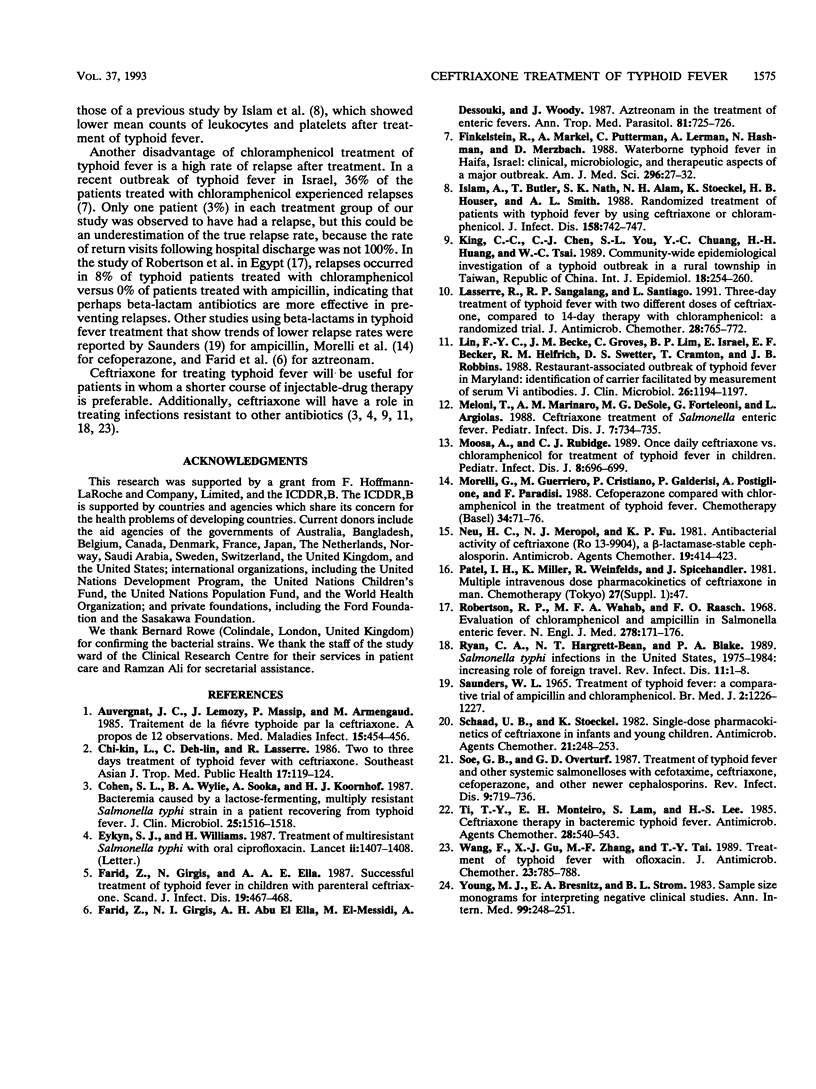Abstract
To compare the therapeutic efficacy of ceftriaxone given once daily for 5 days and chloramphenicol given four times daily for 14 days, a controlled trial was carried out with 59 patients who were culture positive for Salmonella typhi. Ceftriaxone was given to 28 patients in once-daily intravenous doses of 75 mg/kg of body weight to children and 4 g to adults for 5 days; chloramphenicol was given to 31 patients at a dosage of 60 mg/kg/day until defervescence and then at 40 mg/kg/day to complete 14 days of treatment. All Salmonella isolates were susceptible to both antibiotics. Clinical cures (defervescence without complications, no relapse, and no need for further treatment) occurred in 79% of the patients treated with ceftriaxone and 90% of those treated with chloramphenicol (P = 0.37). On the third day of treatment, blood cultures were positive for S. typhi for 60% of the patients in the chloramphenicol group and 0% of the ceftriaxone group (P = 0.001). Defervescence occurred in half the patients in both groups during the first 7 days, but on days 9 to 13 after the start of treatment, nine patients in the ceftriaxone group, compared with six patients in the chloramphenicol group, remained febrile (P = 0.4). The median hematocrit and total leukocyte counts at day 14 were significantly lower for the chloramphenicol group than those for the ceftriaxone group (P = 0.01 and P = 0.02, respectively). These results indicate that the effects of therapy with ceftriaxone for typhoid fever differed from those of chloramphenicol therapy in that blood cultures became negative earlier, prolonged fever persisted in some patients, and bone marrow suppression was reduced. We conclude that a short, 5-day course of ceftriaxone is a useful alternative to conventional 14-day chloramphenicol therapy in the treatment of typhoid fever.
Full text
PDF



Selected References
These references are in PubMed. This may not be the complete list of references from this article.
- Cohen S. L., Wylie B. A., Sooka A., Koornhof H. J. Bacteremia caused by a lactose-fermenting, multiply resistant Salmonella typhi strain in a patient recovering from typhoid fever. J Clin Microbiol. 1987 Aug;25(8):1516–1518. doi: 10.1128/jcm.25.8.1516-1518.1987. [DOI] [PMC free article] [PubMed] [Google Scholar]
- Eykyn S. J., Williams H. Treatment of multiresistant Salmonella typhi with oral ciprofloxacin. Lancet. 1987 Dec 12;2(8572):1407–1408. doi: 10.1016/s0140-6736(87)91308-0. [DOI] [PubMed] [Google Scholar]
- Farid Z., Girgis N. I., Abu el Ella A. H., el-Messidi M., Dessouki A., Woody J. Aztreonam in the treatment of enteric fevers. Ann Trop Med Parasitol. 1987 Dec;81(6):725–726. doi: 10.1080/00034983.1987.11812176. [DOI] [PubMed] [Google Scholar]
- Farid Z., Girgis N., Abu el Ella A. Successful treatment of typhoid fever in children with parenteral ceftriaxone. Scand J Infect Dis. 1987;19(4):467–468. doi: 10.3109/00365548709021680. [DOI] [PubMed] [Google Scholar]
- Finkelstein R., Markel A., Putterman C., Lerman A., Hashman N., Merzbach D. Waterborne typhoid fever in Haifa, Israel: clinical, microbiologic, and therapeutic aspects of a major outbreak. Am J Med Sci. 1988 Jul;296(1):27–32. doi: 10.1097/00000441-198807000-00006. [DOI] [PubMed] [Google Scholar]
- Islam A., Butler T., Nath S. K., Alam N. H., Stoeckel K., Houser H. B., Smith A. L. Randomized treatment of patients with typhoid fever by using ceftriaxone or chloramphenicol. J Infect Dis. 1988 Oct;158(4):742–747. doi: 10.1093/infdis/158.4.742. [DOI] [PubMed] [Google Scholar]
- King C. C., Chen C. J., You S. L., Chuang Y. C., Huang H. H., Tsai W. C. Community-wide epidemiological investigation of a typhoid outbreak in a rural township in Taiwan, Republic of China. Int J Epidemiol. 1989 Mar;18(1):254–260. doi: 10.1093/ije/18.1.254. [DOI] [PubMed] [Google Scholar]
- Lan C. K., Cheng D. L., Lasserre R. Two to three days treatment of typhoid fever with ceftriaxone. Southeast Asian J Trop Med Public Health. 1986 Mar;17(1):119–124. [PubMed] [Google Scholar]
- Lasserre R., Sangalang R. P., Santiago L. Three-day treatment of typhoid fever with two different doses of ceftriaxone, compared to 14-day therapy with chloramphenicol: a randomized trial. J Antimicrob Chemother. 1991 Nov;28(5):765–772. doi: 10.1093/jac/28.5.765. [DOI] [PubMed] [Google Scholar]
- Lin F. Y., Becke J. M., Groves C., Lim B. P., Israel E., Becker E. F., Helfrich R. M., Swetter D. S., Cramton T., Robbins J. B. Restaurant-associated outbreak of typhoid fever in Maryland: identification of carrier facilitated by measurement of serum Vi antibodies. J Clin Microbiol. 1988 Jun;26(6):1194–1197. doi: 10.1128/jcm.26.6.1194-1197.1988. [DOI] [PMC free article] [PubMed] [Google Scholar]
- Meloni T., Marinaro A. M., Desole M. G., Forteleoni G., Argiolas L. Ceftriaxone treatment of Salmonella enteric fever. Pediatr Infect Dis J. 1988 Oct;7(10):734–735. doi: 10.1097/00006454-198810000-00015. [DOI] [PubMed] [Google Scholar]
- Moosa A., Rubidge C. J. Once daily ceftriaxone vs. chloramphenicol for treatment of typhoid fever in children. Pediatr Infect Dis J. 1989 Oct;8(10):696–699. doi: 10.1097/00006454-198910000-00007. [DOI] [PubMed] [Google Scholar]
- Morelli G., Guerriero M., Cristiano P., Galderisi P., Postiglione A., Paradisi F. Cefoperazone compared with chloramphenicol in the treatment of typhoid fever. Chemotherapy. 1988;34(1):71–76. doi: 10.1159/000238550. [DOI] [PubMed] [Google Scholar]
- Neu H. C., Meropol N. J., Fu K. P. Antibacterial activity of ceftriaxone (Ro 13-9904), a beta-lactamase-stable cephalosporin. Antimicrob Agents Chemother. 1981 Mar;19(3):414–423. doi: 10.1128/aac.19.3.414. [DOI] [PMC free article] [PubMed] [Google Scholar]
- Patel I. H., Miller K., Weinfeld R., Spicehandler J. Multiple intravenous dose pharmacokinetics of ceftriaxone in man. Chemotherapy. 1981;27 (Suppl 1):47–56. doi: 10.1159/000238029. [DOI] [PubMed] [Google Scholar]
- Robertson R. P., Wahab M. F., Raasch F. O. Evaluation of chloramphenicol and ampicillin in salmonella enteric fever. N Engl J Med. 1968 Jan 25;278(4):171–176. doi: 10.1056/NEJM196801252780401. [DOI] [PubMed] [Google Scholar]
- Ryan C. A., Hargrett-Bean N. T., Blake P. A. Salmonella typhi infections in the United States, 1975-1984: increasing role of foreign travel. Rev Infect Dis. 1989 Jan-Feb;11(1):1–8. doi: 10.1093/clinids/11.1.1. [DOI] [PubMed] [Google Scholar]
- Sanders W. L. Treatment of typhoid fever: a comparative trial of ampicillin and chloramphenicol. Br Med J. 1965 Nov 20;2(5472):1226–1227. doi: 10.1136/bmj.2.5472.1226. [DOI] [PMC free article] [PubMed] [Google Scholar]
- Schaad U. B., Stoeckel K. Single-dose pharmacokinetics of ceftriaxone in infants and young children. Antimicrob Agents Chemother. 1982 Feb;21(2):248–253. doi: 10.1128/aac.21.2.248. [DOI] [PMC free article] [PubMed] [Google Scholar]
- Soe G. B., Overturf G. D. Treatment of typhoid fever and other systemic salmonelloses with cefotaxime, ceftriaxone, cefoperazone, and other newer cephalosporins. Rev Infect Dis. 1987 Jul-Aug;9(4):719–736. doi: 10.1093/clinids/9.4.719. [DOI] [PubMed] [Google Scholar]
- Ti T. Y., Monteiro E. H., Lam S., Lee H. S. Ceftriaxone therapy in bacteremic typhoid fever. Antimicrob Agents Chemother. 1985 Oct;28(4):540–543. doi: 10.1128/aac.28.4.540. [DOI] [PMC free article] [PubMed] [Google Scholar]
- Wang F., Gu X. J., Zhang M. F., Tai T. Y. Treatment of typhoid fever with ofloxacin. J Antimicrob Chemother. 1989 May;23(5):785–788. doi: 10.1093/jac/23.5.785. [DOI] [PubMed] [Google Scholar]
- Young M. J., Bresnitz E. A., Strom B. L. Sample size nomograms for interpreting negative clinical studies. Ann Intern Med. 1983 Aug;99(2):248–251. doi: 10.7326/0003-4819-99-2-248. [DOI] [PubMed] [Google Scholar]


